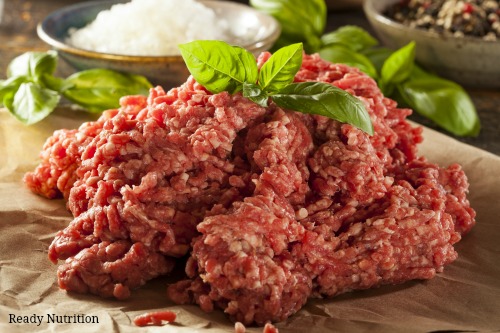
ReadyNutrition Readers, as you’ve undoubtedly read in some of my previous articles, protein is a major consideration in any undertaking that you have. As a matter of fact, it is critical to your survival. We have discussed its importance before, and I wanted to give you guys and gals some methods for utilizing ground beef to keep that protein flowing into your systems. Remember this: almost every food can be effectively blended in a blender. The smaller and more pulverized the better!
Ground Beef is a Frugal SHTF Meat Source
Seriously, guys and gals, ground beef is really great. Firstly, the taste is such that it (as a meat, and a protein) provides satiety, that is a sense of being filled/sated. When you combine that with an 85% lean or higher regarding fat, and make it organic, grass-fed beef…you’re taking in some nutritious protein.
Per the tables in Taber’s Cyclopedic Medical Dictionary (17th Ed.), 3 ounces of lean ground beef contains 21 grams of protein. Most people can eat between ¼ and ½ lb. at a sitting, so we’re looking at 28 to 56 grams of protein right there.
A Few Nifty Ways To Have Ground Beef Ready To Go!
Now, let me tell you what I do. I’ll take about 10 lbs. at a time, and make really lean hamburgers out of about 5 lbs. of it in about ¼ lb. patties. I chop up onions, garlic, parsley, and the like, and throw that in. The other 5 lbs. I brown it on the stove, drain it, and then add ¼ cup of extra virgin olive oil and the aforementioned herbs and seasonings. I’ll keep it in 1 lb. Ziploc bags and freeze about three pounds of it. The other two I’ll keep in the fridge.
Adding this ground beef ¼ lb. at a time to other things, I boost the protein content quite a bit. If you read that article I wrote on the uses of the thermos, you’ll find that I’m a big vitamin-R guy…that’s “Ramen” …for a light lunch/snack and a quick pick-me-up. With a sandwich bag holding my browned ground beef, I turn the 8 grams of protein in the Ramen to 36 g in the blink of an eye.
See, if you pack up these little sandwich bags with about ¼ lb. of the ground beef, you can add it into whatever you like. Tomato soup is nothing…but you can go somewhere and have a bowl and throw the ground beef into it and there’s your protein. Same as if you pick up a salad, the bag of ground beef. Why not? Whatever your dressing is, throw in the ground beef and mix it all in well. Why not add some delicious protein to your salad that makes you feel fuller? Even something such as a bowl of macaroni and cheese…add your ground beef, and go from about 16 g of protein to the cup to a full 44 g.
I have mentioned all of this to give you some ideas if you’re on the go and used to buying your food when you’re at work or such. Know what else you can do, after you’ve cooked it up? Dehydrate it! Yes, indeedy! That is with a food dehydrator (the time will vary for the number of trays you intend to do) or with your oven. For the oven, you should throw it on about 150 degrees F for about 8 to 10 hours if you already browned it (for about 5 lbs.). When it’s done, allow it to cool off, then wrap it up and refrigerate it. This is especially good in soups, and to figure out what the protein content is you’ll have to do a weight by proportion. Note: Meats with high fat content tend to produce beads of oil as it dehydrates and should be blotted off during the dehydration process. Look for meat that has less than 15% fat content.
If you browned about 5 lbs., and then dried it in the oven, you may have about 2 lbs. left over. Calculate your original pre-cooked weight into 4 ounce increments (that would be 4 per pound…and 5 lbs. makes twenty total, right?). Then divide your 2 lbs. by 20, and each increment would hold a normally-cooked amount’s worth of protein…so each increment would be 28 grams of protein worth…minus the water. Just as an example so you can figure out how to do your own. Incidentally, the Taber’s I mentioned doesn’t have the food tables in editions after the 17th, and the tables list every food known to man within reason.
You can also take that ground beef and make pemmican out of it using my recipe with just minor adjustments in terms of fat incorporated into the recipe. As I mentioned before, all of this depends upon the fat content of the ground beef you use. Put in into anything that you have in your diet. I even make mashed potatoes and mix the ground beef in with it. Works good, and tastes pretty good, too. Try out some of these ideas, and you’ll find it really helps you with your workouts and training when protein is your main requirement. Eat heartily, and take care of yourselves! JJ out!
This article was originally published at Ready Nutrition™ on January 26th, 2017






